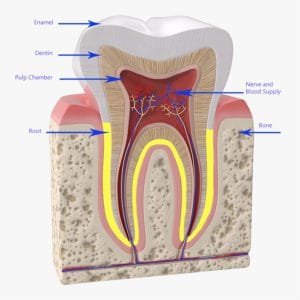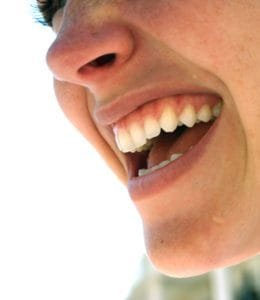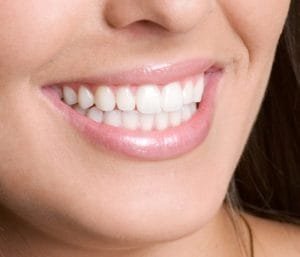How Many Teeth Do Humans Have?
As your local family dentist in San Marcos, our patients are often asked this very question. The short answer is 32. But our adult teeth and baby teeth preceding them have such an impact on our life. Their presence and location determine how the lower half of the face develops in relation to the rest of the face. In essence, the teeth impact our looks, the way we breathe, and what we can eat. Let’s look at how important teeth are to our daily lives by diving into the tooth anatomy.
Teeth Have Many Layers
The Enamel Layer
Anatomically speaking, a tooth has three layers or parts. The outermost layer, which we can see with our eyes, is the enamel. Enamel is the toughest, most robust material in the human body. It protects the teeth against damage and trauma. As the enamel layer contains no nerve endings, small cavities don’t hurt.
The Dentin Layer
Underneath the enamel is the dentin layer. Dentin is not as strong as enamel. It acts as a buffer between the outer glass-like enamel layer and the nerve bundle located deep inside the tooth. While it contains no nerve endings, the dentin communicates with the tooth’s nerve using tiny little channels (like tunnels). When a cavity reaches the dentin, it leads to tooth sensitivity, such as cold and sweets. As the cavity gets bigger, the symptoms become more severe and last longer too.
The Pulp Chamber
The pulp is located in the innermost section of the tooth: the pulp chamber. The pulp includes the nerve and blood supply to the tooth. It is responsible for bringing nutrients to the tooth and transmitting sensation (e.g., toothache, biting the tip of the fork. etc.) When a cavity gets to the nerve, severe pain is usually a common symptom. Infections also become an issue as the bacteria can now invade the bloodstream.
The Root
There is another part of the tooth not often discussed. And that’s because it’s on the root of the tooth. The root’s chemical structure is different than the other layers. It is a cross between the enamel and dentin layers. Typically the roots are not visible to the naked eye as they are usually covered by the gums and embedded in the jawbone. You can start seeing the root surface when the gums recede and pull away.
The tooth root acts as an anchor and holds the tooth attached to the jaw. It is more prone to tooth decay than enamel. It is also more sensitive and may result in nerve damage. All the nerve and blood vessels travel thru the center of the root and culminate in the pulp.
Now that we have a better picture of what a tooth looks like let’s talk about our first set of teeth: the baby teeth.
Baby Teeth – And When We Lose Them
Humans have two sets of teeth. “Baby” teeth are the first of two groups. The first baby tooth starts coming into the mouth when the infant is about six months old. The last of the baby teeth come in when the child is about two years of age. In all, there are twenty baby teeth by the time the child is about two years old. Girls often teeth faster than boys.
As more baby teeth erupt, the child can chew more solid food and transition from baby to adult foods. Baby teeth are responsible for the jawbones growing proportionally. When a baby tooth comes in crooked or is lost prematurely, the jawbones do not develop naturally, leading to complications in breathing, chewing, and facial development, not to mention confidence.
Baby teeth are similar to adult teeth, with one exception. Baby teeth are smaller and have shorter roots. Their smaller size helps the tooth shedding process as the baby tooth slowly loosens up and falls out once the adult tooth is ready to come in. There are times that baby teeth do not fall out on their own. The dentist must remove the over-retained tooth. Delay in removing these teeth can harm the child’s dental and physical development.
Teeth Adults Have On Top Jaw
 An adult tooth replaces each baby tooth. And on top of that, we get 12 more adult teeth with no baby teeth counterparts. There are a total of sixteen teeth on the top jaw of a human adult. These teeth are larger than the baby teeth, and there are more of them, promoting further jaw growth and development. The top teeth have a significant impact on the lip support, the esthetics of the smile, and the extent to which the lower jaw develops.
An adult tooth replaces each baby tooth. And on top of that, we get 12 more adult teeth with no baby teeth counterparts. There are a total of sixteen teeth on the top jaw of a human adult. These teeth are larger than the baby teeth, and there are more of them, promoting further jaw growth and development. The top teeth have a significant impact on the lip support, the esthetics of the smile, and the extent to which the lower jaw develops.
Teeth Adults Have On Bottom Jaw
There are sixteen adult teeth on the bottom jaw, similar to the top. And like the upper teeth, the lower teeth replace the ten lower baby teeth and then some. These teeth have a tremendous impact on the length of the face, chin position, lip prominence, and airway and chewing. If some teeth come in crooked or missing altogether, it usually leads to a shift in the lower jaw to one side or another. The same holds if the upper jaw is missing a tooth. Shifting of the jaw too much leads to symptoms like TMJ and headaches.
Furthermore, missing teeth lead to underdevelopment of the jawbone. The tongue, being attached to the lower jaw, lives within its confines. If there is not sufficient room for the tongue, it starts getting pushed up and back, leading to interference with our breathing. These patients have a higher risk for snoring and developing obstructive sleep apnea.
Adult teeth start erupting about six years of age. Once again, girls get their adult teeth faster than boys. And while most of our adult teeth come in by about 12-14 years of age, our wisdom teeth don’t erupt ‘til we’re in our late teens.
Wisdom Teeth
Wisdom teeth are the last of the adult teeth to erupt into the mouth. They’re referred to as “wisdom” teeth reflecting the older age of the individual and that somehow they are wiser just because of their age.
Regardless of their name, wisdom teeth are considered molars. And specifically, they are the third set of molars to erupt into the mouth. Sometimes they are regular-sized (which is still smaller than the first two sets). And at times, like a spare car tire, they are tiny.
For a long time, wisdom teeth were slated for extraction as a rule. So much so that patients always ask if they need to have their children’s wisdom teeth pulled. To this day, when one joins the armed forces, the military will pay for your wisdom teeth to be removed, and declining is not an option. This trend, however, has been changing for some time now, at least in civilian life. Nowadays, wisdom teeth are typically left alone until they start to cause issues. When the extraction is necessary, it is often due to a lack of space and angulation with respect to the jawbone and other teeth. The patient’s symptoms, potential developmental issues, and surgical considerations play a significant role in making this decision.
TEETH – FACIAL AND AIRWAY key
 Teeth have a tremendous impact not just on our smile but also on our survival and quality of life. Even though we have 32 adult teeth, to begin with, most of us end up with 28 (after removing the four wisdom teeth). Some of us even lose more teeth because of braces, leaving only 24 teeth. And there are lots of people that have one or more teeth pulled or missing for other reasons than the ones we talked about already. If our finger is hurting or broken, we don’t even begin to consider cutting it off. Why is it that people often have a “bad” tooth extracted without a second of doubt? Is it because we have so many more left? When we consider each tooth’s importance in the mouth, we realize that removing teeth is not a good choice. At Platinum Dental, Inc., our doctor carefully monitors your teeth’ health and the other essential functions that the teeth are performing. If it has been a while since you had your teeth checked, or if you suspect something is going on, contact us, and we’ll get you an appointment fast.
Teeth have a tremendous impact not just on our smile but also on our survival and quality of life. Even though we have 32 adult teeth, to begin with, most of us end up with 28 (after removing the four wisdom teeth). Some of us even lose more teeth because of braces, leaving only 24 teeth. And there are lots of people that have one or more teeth pulled or missing for other reasons than the ones we talked about already. If our finger is hurting or broken, we don’t even begin to consider cutting it off. Why is it that people often have a “bad” tooth extracted without a second of doubt? Is it because we have so many more left? When we consider each tooth’s importance in the mouth, we realize that removing teeth is not a good choice. At Platinum Dental, Inc., our doctor carefully monitors your teeth’ health and the other essential functions that the teeth are performing. If it has been a while since you had your teeth checked, or if you suspect something is going on, contact us, and we’ll get you an appointment fast.
